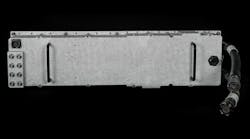Lockheed Martin recently introduced a new radar technology based on gallium-nitride (GaN) solid-state transmitters, which will eventually serve as a modular replacement for the silicon bipolar-junction transistors (BJT) used in its ground-based surveillance radars.
The Digital Array Row Transceiver system, also known as the DART radar, exploits the significantly high operating temperatures of GaN transmitters to reduce array power consumption, lowering the life-cycle costs and increasing the reliability of the radars, Lockheed Martin says.
Mark Mekker, Lockheed Martin’s director of surveillance radar, said in an e-mail to Microwaves & RF that with “GaN technology, the power-handling capability and higher-junction temperature tolerances of the DART provide the opportunity to increase transmit duty-cycle on the radar system to provide greater power output.”
The new radar was engineered as GaN technology is growing more widespread and production processes are being scaled to greater yields. According to a recent Strategy Analytics report, the market for GaN radio frequency devices is predicted to reach around $560 million in 2019. The report suggests that this growth is largely due to its steady presence in military-grade radars, in addition to its increased usage in wireless infrastructure.
Aside from the benefits gained from GaN materials, the DART radar combines the row transmitter and row receiver into a single line replaceable unit (LRU). Mekker added that DART was designed to take the place of five different parts in legacy ground-based radars, decreasing the failure rate of the LRUs it replaces by over 50%. In addition, the DART’s modular design gives technicians better visibility into the health of the radar system, he said.
The DART was launched in Lockheed Martin’s TPS-77 Multi-Role Radar system, which was first issued to the Ministry of Defense of Latvia earlier this year. According to a news release, Latvia’s version of the TPS-77 system was designed to perform different roles as the radar rotates through its 360-deg. scan. When facing one direction, it can perform long-range flight surveillance and automatically adjust to search for medium-range, low-level aircraft in another region.
